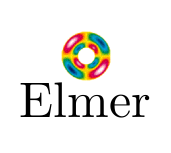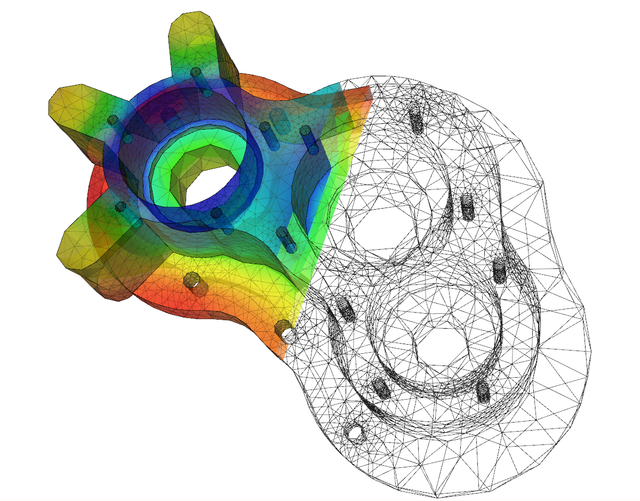Elmer is a finite element software package for the solution of partial differential equations. Elmer can deal with a great number of different equations, which may be coupled in a generic manner making Elmer a versatile tool for multiphysical simulations. As an open source software, Elmer also gives the user the means to modify the existing solution procedures and to develop new solvers for equations of interest to the user.
The development of Elmer was started in 1995 as part of a national CFD technology program funded by the Finnish funding agency for technology and innovation, Tekes. The original development consortia included partners from CSC – IT Center for Science (formerly known as CSC Scientific Computing). Helsinki University of Technology HUT, VTT Technical Research Centre of Finland, University of Jyväskylä, and Okmetic Ltd. CSC is a governmental non-profit company fully owned by the Ministry of Education. After the five years initial project ended the development has been continued by CSC in different application fields.
In September 2005 Elmer was released under GNU General Public License (GPL). This has widened the
user community, particularly the number of international users has grown. However, as the sole owner of
the copyright to Elmer source code, CSC may distribute Elmer also under other licensing terms. Therefore,
if GPL does not suit your purposes, you may contact the Elmer team for other licensing options.
Elmer is distributed only through the Internet. The actual distribution site may vary but the pointer to the
location may always be found at http://www.csc.fi/elmer
The distribution of Elmer comes in three different parts: sources, binaries, and documentation. Unix
users are encouraged to compile the software themselves. The compilation instructions are given at the
www-page. For Windows and Macintosh a precompiled binary version of the code is also provided. The
documentation of the software is already quite extensive, but unfortunately still not complete.
Elmer offers a wide range of methods and techniques for the computational modeling of physical phenomena described by partial differential equations. In the following some of the most essential ones are summarized.
The Elmer package contains solvers for a variety of mathematical models. The following list summarizes
the capabilities of Elmer in specialized fields.
- Heat transfer: models for conduction, radiation and phase change
- Fluid flow: the Navier-Stokes, Stokes and Reynolds equations, k-ε model
- Species transport: generic convection-diffusion equation
- Elasticity: general elasticity equations, dimensionally reduced models for plates and shells
- Acoustics: the Helmholtz equation, linearized Navier–Stokes equations in the frequency domain and
large-amplitude wave motion of an ideal gas - Electromagnetism: electrostatics, magnetostatics, the A-V formulation, magnetic induction, the vectorial Helmholtz equation
- Microfluidics: slip conditions, the Poisson-Boltzmann equation
- Levelset method: Eulerian free boundary problems
- Quantum Mechanics: density functional theory (Kohn-Sham)
For approximation and linear system solution Elmer offers a great number of possibilities. The following
list summarizes some of the most essential ones.
- All basic finite elements based on the Lagrange interpolation of degree k ≤ 3 (1D and 2D) or k ≤ 2
(3D). - Higher degree approximation using p-elements
- Curl-conforming (edge) finite elements of degree k ≤ 2 for basic element shapes
- Triangular, quadrilateral, tetrahedral and hexahedral div-conforming (face) finite elements of the lowest degree
- Time integration schemes for the first and second order equations
- Solution methods for eigenvalue problems
- Direct linear system solvers (Lapack & Umfpack)
- Iterative Krylov subspace solvers for linear systems
- Multigrid solvers (GMG and AMG) for some basic equations
- ILU preconditioning of linear systems
- Parallelization of iterative methods
- The discontinuous Galerkin method
- Stabilized finite element formulations, including the methods of residual free bubbles and SUPG
- Adaptivity, particularly in 2D
- BEM solvers (without multipole acceleration)
Potential users may find a list of the possible pros and cons of Elmer package useful. The following summary
is naturally open to subjective judgment and not complete either.
- Since Elmer is an open source product, it is possible to verify and modify the solution procedures.
- Elmer has a modern programmable graphical user interface.
- Elmer can handle the coupling of field equations in a flexible manner and new field variables can be
introduced easily. - All material parameters may depend on the field variables and other parameters in a free manner.
- Elmer offers a large selection of modern numerical methods.
- Elmer enables the user generally to use the most common finite elements.
- Both assembly and iterative solution can also be done in parallel. Good scaling has been obtained up
to thousands of processors. - Elmer has a graphical preprocessing interface for simple problem setups.
- Elmer is easily compiled for most Unix systems and it is also available for Windows and some Linux
distributions as precompiled binaries. - Elmer has a steadily growing user community and it has already been used in tens of scientific papers.
- The different aspects of the code (solver, interface, documentation) are not always at the same development phase. For example documentation is not up-to-date and the graphical user interface lacks
many of the more esoteric physical models provided by the solver. - Getting acquainted with the large package may take time. Previous experience on FEM packages may
therefore be useful. - Elmer itself does not include proper geometry or mesh generation tools for geometrically complicated
problems. Only mesh import interfaces are supported. - As a multiphysical solver Elmer may sometimes lack features in some areas that are standard for
established single-field codes. Thus, some users may find the capabilities of Elmer inadequate for
their needs.



